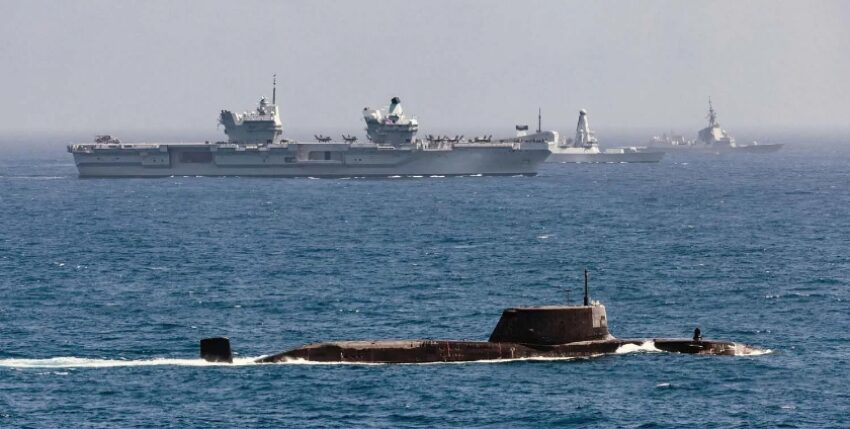The British Carrier Strike Group (CSG 25) with the aircraft carrier HMS Prince of Wales and a multinational convoy set course for the Mediterranean at the end of April. This marks the start of an eight-month deployment under the name "Operation Highmast" - which will take the Royal Navy together with allies to the Mediterranean, the Middle East, the Indian Ocean and the Indo-Pacific.
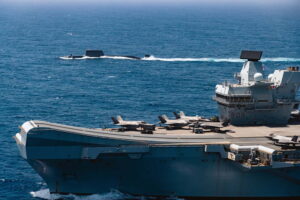
The association includes the destroyer HMS Dauntless (Type 45), the frigate HMS Richmond (Type 23), the suppliers HMS Tidespring and HMS Tideforce (in the first phases of the voyage), as well as the nuclear-powered fighter submarine HMS Astute. A fact that 'Mer et Marine' finds remarkable, as only two of the five British SSNs are currently operational. The organisation is complemented by international partners: the Spanish frigate Méndez Núñezthe Norwegian Roald Amundsen and the supplier Maud. The Canadian frigate HMCS Ville de Québec is to be integrated later. On board the Prince of Wales There are currently at least 12 F-35B fighter jets on the carrier. Theoretically, the carrier can currently accommodate 18 aircraft, but this is expected to rise to 24 in the later stages of the mission. Merlin helicopters and unmanned systems are also part of the aircraft contingent.
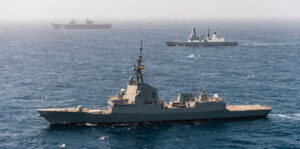
The commander of the task force, Commodore James Blackmore, explained that the aim was to demonstrate a convincing deterrent and reaffirm the UK's commitment to defending the rules-based international order. Defence Secretary John Healey emphasised that the UK was one of the few countries capable of leading such a complex multinational carrier group.
Strategy in the Indo-Pacific: alliance building and deterrence
The deployment follows London's strategic realignment in 2021 with an increased focus on the Indo-Pacific. The deployment sends a clear signal to partner nations such as Japan, Australia, the USA and Canada that the UK remains committed. The CSG will participate in a variety of bilateral and multilateral manoeuvres, including La Pérouse, Talisman Sabre and exercises with ASEAN countries.
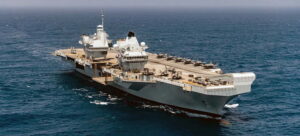
In doing so, London emphasises the need to link Euro-Atlantic and Indo-Pacific security interests. Even though Jens Stoltenberg is no longer NATO Secretary General, his statement remains relevant: "Europe's security is linked to Asia's security - and vice versa." In fact, the mission also reinforces the NATO doctrine of thinking about threats globally.
China is criticising the deployment. The Chinese state newspaper Global Times mockingly commented that Britain was indulging in "imperial nostalgia" when it exposed itself on Taiwan issues. Beijing's growing naval expansion, aggressive territorial claims in the South China Sea and intensive naval manoeuvres illustrate the tense situation. Even if London emphasises that these are routine manoeuvres, the CSG deployment is also an indirect signal to China: Europe is not absent.
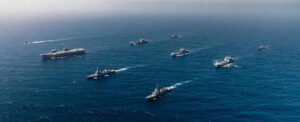
European-transatlantic framework
Within Europe, the mission is characterised by deeper political coordination. In addition to the close bilateral cooperation with France - including joint air defence exercises this year - there is increasing cooperation between carriers, e.g. with Italy's Cavour. The CSG forms the backbone of this interoperability. At the same time, the UK is demonstrating to its partners that it remains an active European player in terms of security policy despite Brexit.
At the transatlantic level, the mission complements the US burden-sharing strategy. US commentators welcome the British commitment as it relieves the burden on American carrier groups, creates strategic depth and demonstrates solidarity. For NATO, it means a visible maritime strategic presence from the Atlantic to the Western Pacific.

Reactions and discussion
Within the UK, there is criticism centred on the state of the fleet: The Navy Blog Navy Lookout points to the low number of deployable units. Critics demand that the focus should once again be more on European deterrence against Russia. Those in favour counter that a global presence does not rule out European obligations.
France is largely in favour of the mission. The French naval leadership has been emphasising the complementarity of the European carrier fleets for years. Joint exercises with the Charles de Gaulle strengthen mutual trust. There is also support from the Scandinavian countries for linking European and Indo-Pacific security.
Symbolism with substance
The CSG-25 deployment is more than just a demonstration of power. It shows that the UK is able to realise maritime power projection globally - despite challenges in terms of infrastructure and personnel. The involvement of international partners lends the mission geopolitical weight. The strategic impact will have to be measured by the question of how credible and lasting this commitment remains - towards partners and rivals alike.
With "Highmast", the Royal Navy is once again emphasising its claim to be a globally operational navy. For Europe, NATO and the Indo-Pacific region, the mission is a signal: the maritime order is being defended - not in isolation, but as part of a network.
hum

